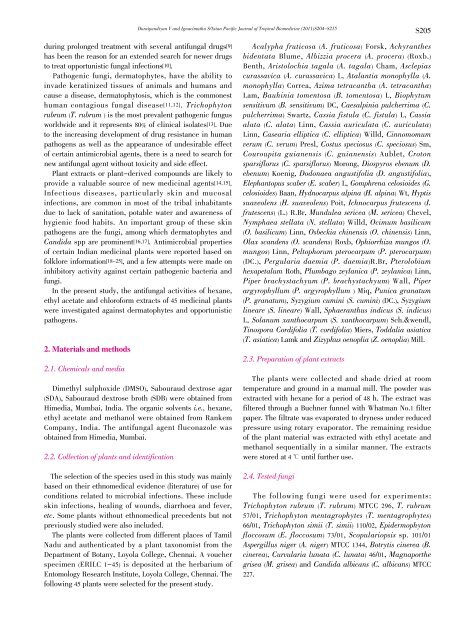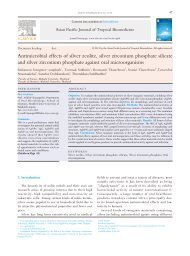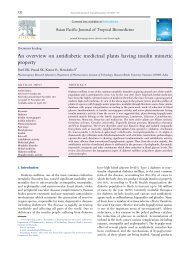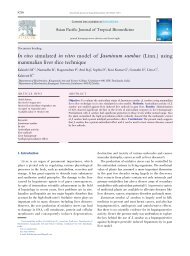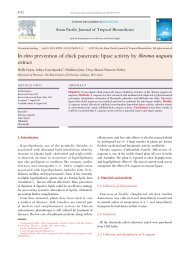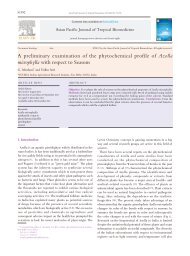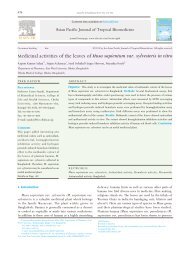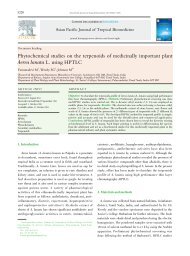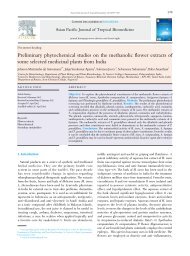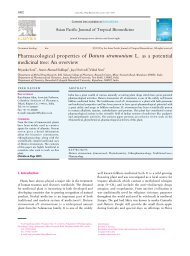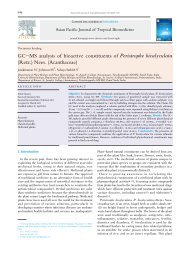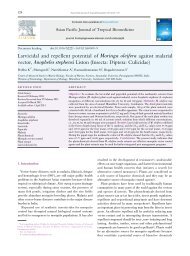Antifungal activity of traditional medicinal plants from Tamil - Apjtb.com
Antifungal activity of traditional medicinal plants from Tamil - Apjtb.com
Antifungal activity of traditional medicinal plants from Tamil - Apjtb.com
You also want an ePaper? Increase the reach of your titles
YUMPU automatically turns print PDFs into web optimized ePapers that Google loves.
Duraipandiyan V and Ignacimuthu S/Asian Pacific Journal <strong>of</strong> Tropical Biomedicine (2011)S204-S215 S205<br />
during prolonged treatment with several antifungal drugs[9]<br />
has been the reason for an extended search for newer drugs<br />
to treat opportunistic fungal infections[10].<br />
Pathogenic fungi, dermatophytes, have the ability to<br />
invade keratinized tissues <strong>of</strong> animals and humans and<br />
cause a disease, dermatophytosis, which is the <strong>com</strong>monest<br />
human contagious fungal disease[11,12]. Trichophyton<br />
rubrum (T. rubrum ) is the most prevalent pathogenic fungus<br />
worldwide and it represents 80% <strong>of</strong> clinical isolates[13]. Due<br />
to the increasing development <strong>of</strong> drug resistance in human<br />
pathogens as well as the appearance <strong>of</strong> undesirable effect<br />
<strong>of</strong> certain antimicrobial agents, there is a need to search for<br />
new antifungal agent without toxicity and side effect.<br />
Plant extracts or plant-derived <strong>com</strong>pounds are likely to<br />
provide a valuable source <strong>of</strong> new <strong>medicinal</strong> agents[14,15].<br />
Infectious diseases, particularly skin and mucosal<br />
infections, are <strong>com</strong>mon in most <strong>of</strong> the tribal inhabitants<br />
due to lack <strong>of</strong> sanitation, potable water and awareness <strong>of</strong><br />
hygienic food habits. An important group <strong>of</strong> these skin<br />
pathogens are the fungi, among which dermatophytes and<br />
Candida spp are prominent[16,17]. Antimicrobial properties<br />
<strong>of</strong> certain Indian <strong>medicinal</strong> <strong>plants</strong> were reported based on<br />
folklore information[18-25], and a few attempts were made on<br />
inhibitory <strong>activity</strong> against certain pathogenic bacteria and<br />
fungi.<br />
In the present study, the antifungal activities <strong>of</strong> hexane,<br />
ethyl acetate and chlor<strong>of</strong>orm extracts <strong>of</strong> 45 <strong>medicinal</strong> <strong>plants</strong><br />
were investigated against dermatophytes and opportunistic<br />
pathogens.<br />
2. Materials and methods<br />
2.1. Chemicals and media<br />
Dimethyl sulphoxide (DMSO), Sabouraud dextrose agar<br />
(SDA), Sabouraud dextrose broth (SDB) were obtained <strong>from</strong><br />
Himedia, Mumbai, India. The organic solvents i.e., hexane,<br />
ethyl acetate and methanol were obtained <strong>from</strong> Rankem<br />
Company, India. The antifungal agent fluconazole was<br />
obtained <strong>from</strong> Himedia, Mumbai.<br />
2.2. Collection <strong>of</strong> <strong>plants</strong> and identification<br />
The selection <strong>of</strong> the species used in this study was mainly<br />
based on their ethnomedical evidence (literature) <strong>of</strong> use for<br />
conditions related to microbial infections. These include<br />
skin infections, healing <strong>of</strong> wounds, diarrhoea and fever,<br />
etc. Some <strong>plants</strong> without ethnomedical precedents but not<br />
previously studied were also included.<br />
The <strong>plants</strong> were collected <strong>from</strong> different places <strong>of</strong> <strong>Tamil</strong><br />
Nadu and authenticated by a plant taxonomist <strong>from</strong> the<br />
Department <strong>of</strong> Botany, Loyola College, Chennai. A voucher<br />
specimen (ERILC 1-45) is deposited at the herbarium <strong>of</strong><br />
Entomology Research Institute, Loyola College, Chennai. The<br />
following 45 <strong>plants</strong> were selected for the present study.<br />
Acalypha fruticosa (A. fruticosa) Forsk, Achyranthes<br />
bidentata Blume, Albizzia procera (A. procera) (Roxb.)<br />
Benth, Aristolochia tagala (A. tagala) Cham, Asclepias<br />
curassavica (A. curassavica) L, Atalantia monophylla (A.<br />
monophylla) Correa, Azima tetracantha (A. tetracantha)<br />
Lam, Bauhinia tomentosa (B. tomentosa) L, Biophytum<br />
sensitivum (B. sensitivum) DC, Caesalpinia pulcherrima (C.<br />
pulcherrima) Swartz, Cassia fistula (C. fistula) L, Cassia<br />
alata (C. alata) Linn, Cassia auriculata (C. auriculata)<br />
Linn, Casearia elliptica (C. elliptica) Willd, Cinnomomum<br />
verum (C. verum) Presl, Costus speciosus (C. speciosus) Sm,<br />
Couroupita guianensis (C. guianensis) Aublet, Croton<br />
sparsiflorus (C. sparsiflorus) Morong, Diospyros ebenum (D.<br />
ebenum) Koenig, Dodonaea angustifolia (D. angustifolia),<br />
Elephantopus scaber (E. scaber) L, Gomphrena celosioides (G.<br />
celosioides) Baan, Hydnocarpus alpina (H. alpina) Wt, Hyptis<br />
suaveolens (H. suaveolens) Poit, Ichnocarpus frutescens (I.<br />
frutescens) (L.) R.Br, Mundulea sericea (M. sericea) Chevel,<br />
Nymphaea stellata (N. stellata) Willd, Ocimum basilicum<br />
(O. basilicum) Linn, Osbeckia chinensis (O. chinensis) Linn,<br />
Olax scandens (O. scandens) Roxb, Ophiorrhiza mungos (O.<br />
mungos) Linn, Peltophorum pterocarpum (P. pterocarpum)<br />
(DC.), Pergularia daemia (P. daemia)R.Br, Pterolobium<br />
hexapetalum Roth, Plumbago zeylanica (P. zeylanica) Linn,<br />
Piper brachystachyum (P. brachystachyum) Wall, Piper<br />
argyrophyllum (P. argyrophyllum ) Miq, Punica granatum<br />
(P. granatum), Syzygium cumini (S. cumini) (DC.), Syzygium<br />
lineare (S. lineare) Wall, Sphaeranthus indicus (S. indicus)<br />
L, Solanum xanthocarpum (S. xanthocarpum) Sch.&wendl,<br />
Tinospora Cordifolia (T. cordifolia) Miers, Toddalia asiatica<br />
(T. asiatica) Lamk and Zizyphus oenoplia (Z. oenoplia) Mill.<br />
2.3. Preparation <strong>of</strong> plant extracts<br />
The <strong>plants</strong> were collected and shade dried at room<br />
temperature and ground in a manual mill. The powder was<br />
extracted with hexane for a period <strong>of</strong> 48 h. The extract was<br />
filtered through a Buchner funnel with Whatman No.1 filter<br />
paper. The filtrate was evaporated to dryness under reduced<br />
pressure using rotary evaporator. The remaining residue<br />
<strong>of</strong> the plant material was extracted with ethyl acetate and<br />
methanol sequentially in a similar manner. The extracts<br />
were stored at 4 曟 until further use.<br />
2.4. Tested fungi<br />
The following fungi were used for experiments:<br />
Trichophyton rubrum (T. rubrum) MTCC 296, T. rubrum<br />
57/01, Trichophyton mentagrophytes (T. mentagrophytes)<br />
66/01, Trichophyton simii (T. simii) 110/02, Epidermophyton<br />
floccosum (E. floccosum) 73/01, Scopulariopsis sp. 101/01<br />
Aspergillus niger (A. niger) MTCC 1344, Botrytis cinerea (B.<br />
cinerea), Curvularia lunata (C. lunata) 46/01, Magnaporthe<br />
grisea (M. grisea) and Candida albicans (C. albicans) MTCC<br />
227.


